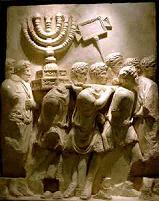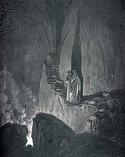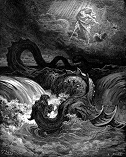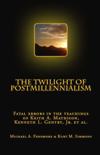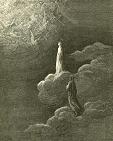Urgent Corrections Preterism Must Make - No. 1
Kurt Simmons
Introduction
St. Paul said, “If any man thinketh he knoweth anything, he knoweth nothing yet as he ought to know.” (I Cor. 8:2) I have been a Preterist almost 26 years. I have learned a few things along the way; one of them is how much I don’t know and still have to learn. This last year, I have learned some new things; I have become aware of a couple areas that appear to me to need correction within the Preterist movement. The first of these has to do with the notion that the eschaton was essentially local; the second that it was essentially covenantal. In this article, I want to address the idea that the eschaton was essentially local.
Mistake Natural
It has been my observation that as Preterists we tend to focus on the fall of Jerusalem to the exclusion of other aspects of the eschaton presented in scripture. This has caused our perception of the eschaton to become out of “skew,” so that it no longer represents the actual picture represented in the scriptures, which shows it was world-wide. However, this mistake is easy to make. The scriptures treat of the fall of Jerusalem and end of the Jewish economy in almost every book of the Bible; its theme is so common and pervasive, that seeing the eschaton in terms of Jerusalem’s fall is natural.
The Jews were God’s chosen people to bring Christ into the world and accomplish his soteriological purpose to redeem mankind. It is therefore natural that the termination of the Jewish nation before God as a chosen people should receive special emphasis in the scripture; the desolation of the holy city and death of almost a million and a half Jews is not something that could be passed over in silence. Moreover, the destruction of Jerusalem was a sign of the end of “world” or “age.” Not the Mosaic age, as Preterists often mistakenly conclude (the phrase does not occur in the Bible), but the end of the “world-age” (ton aiona tou kosmou toutou, Eph. 2:2) – the course of the world that had obtained from the time of Adam’s fall; the world-epoch marked by the dominion of sin and death.
The Jerusalem temple stood as a grand object lesson to every race of people of mankind’s fallenness; its system of worship epitomized the sinful condition of the fallen race and its estrangement from God. Sequestered in the Holy of Holies, man’s Maker could not be approached except through his chosen Intermediary and the sprinkling of blood. The barrier of sin, represented by the great veil before the Holy of Holies, was rent in twain in Christ’s death, showing the way back into God’s presence through the blood of Christ. (Matt. 27:51; cf. Heb. 10:19, 20) The blood offering of Christ carried into the temple in heaven meant that the outward and visible temple in Jerusalem had fulfilled its purpose and needs be removed. This began at the cross when the veil was rent in twain, but was completed when the temple itself was fully and finally destroyed in the war with Rome. The distinction of the Mosaic law between Jew and Gentile was removed for all time. In destroying the temple in A.D. 70, God showed that he was now dealing with men on equal terms as the sons of Adam, not as separate nations, as he had beginning with Babel and the call of Abraham. The fall of the temple was a sign that a new epoch had come. The gospel call invited all mankind to a restored relationship with God.
Examples of Universal Judgment at the Eschaton
As we have seen, the pervasive treatment of Jerusalem’s fall in the Bible makes seeing the eschaton as consisting essentially in that event an easy mistake to make. Nevertheless, it is a mistake just the same, and one that must be corrected. As the following passages show, the eschaton was plainly world-wide.
Dan. 2:28-45 – Thou sawest till that a stone was cut out without hands, which smote the image upon his feet that were of iron and clay, and brake them to pieces.
This is one of the most important prophecies of the Bible and it does not even mention the Jews or Jerusalem. The famous dream of Nebuchadnezzar depicts four world empires until the coming of the kingdom and Messiah; it portrays Christ’s coming in terms of the world government and inhabited earth being reduced to rubble in the days of the fourth world empire and the mountain of the Lord’s kingdom growing up in its place. The rubble to which the image is reduced answer the “elements” of II Pet. 3 and point to the socio-political fabric of the pre-parousia world.
Ps.2:8, 9 – Ask of me, and I shall give thee the heathen for thine inheritance, and the uttermost parts of the earth for thy possession. Thou shalt break them with a rod of iron; thou shalt dash them in pieces like a potter’s vessel.
This Psalm is about the resurrected, glorified Christ and the kingdom given him of the Father. Christ’s kingdom is more than just the church; it includes all earth’s nations, which he rules with a rod of iron, dashing to pieces those that disobey. The dashing here corresponds to the dashing of the image in Nebuchadnezzar’s dream and is eschatological.
Ps. 110:5, 6 – The Lord at thy right hand shall strike through kings in the day of his wrath. He shall judge among the heathen, he shall fill the places with the dead bodies; he shall wound the heads over many countries.
This Psalm, like the one before, speaks to the eschatological day of wrath of Christ upon the heathen; the eschaton would entail the devastation of many countries.
Hag. 2:6, 7; 3:21, 22 – For thus saith the Lord of hosts; Yet once, it is a little while, and I will shake the heavens, and the earth, and the sea, and the dry land; and I will shake all nations, and the desire of all nations shall come: and I will fill this house with glory, saith the Lord of hosts…I will shake the heavens and the earth; and I will overthrow the throne of kingdoms, and I will destroy the strength of the kingdoms of the heathen.”
This verse is important because it is quoted by the Hebrew writer as about to be fulfilled in his day. (Heb. 12:26) Its first application is to the rebuilding of the Jerusalem temple under Zerubbabel; its second and ultimate application was to the kingdom and church of Christ. Haggai foretold a time when the wealth and power of the nations would accrue to the benefit of the Jerusalem temple, by the fall of worldly powers. This became a type of the victory of the church at the eschaton. As Preterists, we have interpreted this passage as quoted by the Hebrew writer in terms of Jerusalem’s fall, but, as we see, its actual, original, and intended scope was universal – the eschaton would be a time when all nations were shaken and the throne of heathen kingdoms overthrown. We should also note that the heavens and earth in this context point to higher powers and earth’s governments; they have no covenantal significance themselves.
Rev. 1:7 – Behold, he cometh with clouds; and every eye shall see him, and they also which pierced him: and all kindreds of the earth shall wail because of him. Even so, Amen.
This last passage can be translated in more narrow terms to say “all the tribes of the land shall wail because of him.” But no translation in print does this, nor would it fit within the imagery of Revelation, which portrays the eschaton in universal terms, far surpassing Judaea and Jerusalem. Moreover, the word “also” – they also which pierced him – meaning the Jews, signifies that they too would see him in addition to earth’s other peoples.
Matt. 25:31, 32 – When the Son of man shall come in his glory, and all the holy angels with him, then shall he sit upon the throne of his glory: and before him shall be gathered all nations: and he shall separate them one from another, as a shepherd divideth his sheep from the goats.
This passage likely refers to the great white throne judgment in Rev. 20:11-15. If so, it is “other worldly.” But, no matter what side of eternity is portrayed, it is clear that the passage refers to more than merely Palestine.
II Tim. 4:1 - I charge thee therefore before God, and the Lord Jesus Christ, who shall judge the quick and the dead at his appearing and his kingdom
The time for the appearing of Christ and his kingdom was within the lives of the apostles. (Matt. 16:27, 28) I confess that I do not know everything that is involved with judging the quick, but I do know that the living includes more than those residing in Palestine. The eschaton was a time when all men came under judgment.
Acts 17:30, 31 – And the times of this ignorance God winked at; but now commandeth all men everywhere to repent: because he hath appointed a day, in the which he is about to judge (melle krinein) the world in righteousness.
Paul spoke these words in Athens. The time of judgment that was about to overtake the world (Gk. kosmos) entailed more than Jews; all men everywhere were about to feel the rod of Christ’s correction for rejecting his gospel and persecuting his church.
These are just a few of the passages holding out a universal coming. As Preterists, we are going to have a hard time meeting opponents in debate and persuading people of an AD 70 fulfillment if we make the argument the eschaton was purely localized in Judea, while ignoring passages showing Christ’s coming was world-wide in breadth and sweep. I would suggest that, not only do these and similar passages point to a world-wide coming of Christ, but that cosmic language used by the prophets carries a similar meaning and import.
The Day & Coming of the Lord in the Prophets
We should acknowledge at the outset that the coming of Christ in the events culminating in the destruction of Jerusalem in AD 70 were not completely unique in history. As Preterists, we have always made appeal to Old Testament examples of the coming and day of the Lord to show the non-literal nature of prophetic language. We have always argued that there have been many comings of the Lord and many days of the Lord down through the centuries. We point to these to show that the New Testament day of the Lord was not in that sense unique, and that Christ’s NT coming would therefore accord with Old Testament examples in that it would be providential, not bodily and visible; and that language of the earth’s being consumed was figurative not literal. A favorite example of prophetic language from the Old Testament is Isaiah 34:
The mountains shall be melted with their blood. And all the host of heaven shall be dissolved, and the heavens shall be rolled together as a scroll: and all their host shall fall down, as the leaf falleth off from the vine, and as a falling fig from the fig tree. For my sword shall be bathed in heaven: behold, it shall come down upon Idumea, and upon the people of my curse, to judgment. Isa. 34:3-5
As Preterists, we correctly point to the figurative nature of the language in this passage. A typical Preterist argument has it that notwithstanding the language of cosmic proportions, the judgment was merely local, involving only Edom. We then point to passages such as II Pet. 3:10-12 as proof that the judgment contemplated there was also local, encompassing only Palestine. But our proof text is defective. A closer reading will show that the judgment upon Edom was, in fact, world-wide. Here is how the whole passage reads:
Come near, ye nations, to hear; and hearken, ye people: let the earth hear, and all that is therein; the world, and all things that come forth of it. For the indignation of the Lord is upon all nations, and his fury upon all their armies: he hath utterly destroyed them, he hath delivered them to the slaughter. Their slain also shall be cast out, and their stink shall come up out of the carcasses, and the mountains shall be melted with their blood. And all the host of heaven shall be dissolved, and the heavens shall be rolled together as a scroll: and all their host shall fall down, as the leaf falleth off from the vine, and as a falling fig from the fig tree. For my sword shall be bathed in heaven: behold, it shall come down upon Idumea, and upon the people of my curse, to judgment. Isa. 34:1-5
Thus, not only is the passage in no way merely local; by its express terms it speaks to a time of wrath upon the whole world, upon all nations, and their armies. The same prophecy, stripped of the poetic imagery, was given by Jeremiah as follows:
Behold, I will send and take all the families of the north, saith the Lord, and Nebuchadnezzar the king of Babylon, my servant, and will bring them against this land, and against the inhabitants thereof, and against all these nations round about, and will utterly destroy them…For thus saith the Lord God of Israel unto me; Take the wine cup of this fury at my hand, and cause all the nations, to whom I send thee to drink it…to wit, Jerusalem and the cities of Judah…Pharaoh king of Egypt…all the mingled people, and all the kings of the land of Uz, and all the kings of the land of the Philistines… Edom, and Moab, and the children of Ammon, all the kings of Tyrus and Zidon…Thus saith the Lord of hosts, Behold, evil shall go forth from nation to nation, and a great whirlwind shall be raised up from the coasts of the earth. And the slain of the Lord shall be at that day from one end of the earth even unto the other end of the earth.” Jer. 25:9ff.
Jeremiah speaks to the same historical period and events as Isaiah, even mentioning Edom specifically. However, what tends to get overlooked in the prophecy of Isaiah comes through loud and clear in Jeremiah: the armies of Nebuchadnezzar would visit judgment upon the whole earth; all nations were to suffer a time of divine wrath. Clearly, the language of cosmic proportions used by Isaiah cannot be understood in reference merely to Edom or any other single nation, but was indicative of the world-wide scope of divine judgment at the hands of the Babylonians. Let us look at yet another favorite proof text of Preterists, and then we are through:
Behold, the day of the Lord cometh, cruel both with wrath and fierce anger, to lay the land desolate: and he shall destroy the sinners thereof out of it. For the stars of heaven and the constellations thereof shall not give their light: the sun shall be darkened in his going forth, and the moon shall not cause her light to shine. And I will punish the world for their evil, and the wicked for their iniquity…I will make a man more precious than fine gold; even man than the golden wedge of Ophir. Therefore I will shake the heavens, and the earth shall remove out of her place in the wrath of the Lord of hosts, and in the day of his fierce anger....This is the purpose that is purposed upon the whole earth: and this is the hand that is stretched out upon all the nations. Isa. 13:9-13; 14:26
Again, we note the language of cosmic proportions. As Preterists, we typically argue that only Babylon is involved, with a view to arguing that II Pet. 3:10 and similar passages have only Judea in view. However, again our text betrays us. Somehow we read past that part of the passage in which God indicates he would “punish the world” through the Medes and Persians as he had punished through the Assyrians and Babylonians before them.
The point: As Preterists, we have focused upon the figurative nature of prophetic language; we have correctly identified that the language of the prophets is not intended to be taken literally; that times of judgment are often couched in language which seems to say the physical creation was coming to an end, but in reality described times of divine judgment upon various nations. However, we have not always seen the big picture, but disconnected portions of the whole. We have not seen that cosmic language in which the heavens and earth are consumed is generally indicative of a time of over-all wrath, not the fall of a single nation. To my knowledge, not a single example can be shown where cosmic language of the sort we are discussing was used to describe the isolated judgment of a single nation. This language might occur in the description of a particular nation’s fall; a whole book of the minor prophets may even deal with one nation’s fall and use this sort of language; but when we step back and take in the larger picture, that one nation invariably was part of the larger, world-wide devastations being wrought at the same time.
World-wide nature of Eschaton in NT
This becomes important when dealing with the eschaton, because while we have recognized the figurative nature of prophetic language in the Old Testament, we have tended only to admit God’s judgment upon Jerusalem into our view, while neglecting to take account of passages that show that the eschaton involved other nations and peoples. For example, while Titus was besieging Jerusalem, his father was besieging Italy and Rome. Yet, we talk only of the siege of Jerusalem. Why? The actual picture that emerges from the New Testament, and Revelation in particular, is world-wide in scope and breath. There are four main characters in Revelation who are the eschatological enemies of Christ and the church:
The Dragon – This is Leviathan, imperial Rome, the world civil power opposing Christ and his church; the political embodiment of world evil; his ten horns are the ten provinces of Rome, his seven heads the ruling Caesars unto the eschaton.
The Beast – This is the persecuting power of the empire; the defining characteristic of a beast is that it devours men; the defining characteristic of this beast is that it makes war against the church and devours the saints. It is driven in Rome by Nero whose name it bore but elsewhere by the harlot.
The False prophet – This is the persecuting power in Palestine under the direction of the rulers of the Jews.
The Harlot – This is Jerusalem and international Jewry, driving the persecution in Asia and throughout the world, where she is depicted in the spiritual wilderness of the Gentiles, driving the beast in a surfeit of blood and gore, waging war against the church. She is said to sit upon many waters, which the angel interprets to mean peoples, nations, multitudes and tongues, signifying the presence of the Jews among the world’s nations, where they instigated persecution of the church. (Rev. 17:15)
Europe, Asia, Palestine. The same image emerges from the epistles which show there was a time of world-wide persecution that would end with Christ’s coming. For example, Thessalonians mentions specifically that their rest from persecution would come when Christ came:
II Thess. 1:6 - Seeing it is a righteous thing with God to recompense tribulation to them that trouble you; and to you who are troubled rest with us, when the Lord Jesus shall be revealed from heaven with his mighty angels.
Thessalonica is in northern Achaia, near Macedonia. How could the fall of Jerusalem in the Middle East bring relief to the saints in Thessalonica unless the eschaton was world-wide? The epistles of I & II Peter are to the same effect. These were addressed to the saints in Pontus, Galatia, Cappadocia, Asia, and Bithynia near Armenia and the southern coast of the Black Sea. Peter’s epistles show that the eschatological battle was occurring even here, and that the saints were under a time of persecution. Significantly, it is to these churches that Peter wrote the promise of a new heavens and earth. (II Pet. 3:13) If the eschaton was local and the heavens and earth of II Pet. 3:10 were symbols of things situated in Palestine, how could churches near the Black Sea receive new heavens and earth by the fall of Jerusalem? The short answer is that language of cosmic proportions was never intended to be interpreted locally or in reference to a single nation, but world-wide.
What follows is a catalogue of world disasters; a survey of the cataclysmic events that overtook the world at the eschaton. We offer these to help demonstrate that Christ’s coming was world-wide and in no way confined to the fall of Jerusalem.
Catalogue of World Disasters
|
Year |
Event in Roman Empire |
|
|
|
|
|
|
AD 60 |
· Revolt of Britons under Queen Boudicca; 160,000 Romans and Britons slain. Dio Cassius describes the atrocities the Britons committed thus: “They hung up naked the noblest and most distinguished women and then cut off their breasts and sewed them to their mouths, in order to make the victims appear to be eating them; afterwards they impaled the women on sharp skewers lengthwise through the entire body. All this they did to the accompaniment of sacrifices, banquets and wanton behavior, not only in all their other sacred places, but particularly in the grove of Andate. This was their name for Victory, and they regarded her with most exceptional reverence.” Dio Cassius, LXII, 7. · The Lycus valley and cities of Laodicea and Colosse were destroyed by earthquakes.
|
|
|
AD 61 |
· Pestilence in Asia and Ephesus
|
|
|
AD 62 |
· The gymnasium in Rome was struck by lightening and burned to the ground, reducing a statute of Nero which it contained to a shapeless lump of bronze. · An earthquake demolished the better part of the populous Campanian town of Pompeii. · A Great famine in Armenia and Palestine
|
|
|
AD 63 |
· Nero’s wife, Poppaea, gives birth to a daughter, which died in less than four months. This child represented the last of Caesarean blood. With the death of Nero, the blood of the Caesars would thus perish from earth. · On the 5th February, 63, the city of Pompeii was nearly engulfed by an earthquake. In 79 it would be completely buried by Vesuvius.
|
|
|
AD 64 |
· The burning of Rome and almost the complete destruction of the city. Rome was divided into 14 regions, of which four remained intact, three were leveled to the ground, in the other seven nothing survived by a few dilapidated houses. One writer described it thus: “The most precious antiquities of Rome, the houses of the ancient leaders decorated yet with triumphal spoils, the most sacred objects, the trophies, the ex-voto antiques, the most esteemed temples—all the material of the old worship of the Romans had disappeared. It was like the funeral of the reminiscences and legends of the fatherland.” Renan, Le Antichrist, p. 75 · Revolt of the gladiators in the town of Praeneste; followed by a huge navel disaster. Nero ordered the fleet to return to Campania by a given date, with no allowance for hazards of the sea. The helmsmen therefore, in spite of a raging storm, put out from port and were destroyed. · Conspiracy to assassinate Nero and place Piso upon the throne is discovered; Nero begins a reign of terror – Lucan, Seneca, and most of Rome’s leading citizens will suffer death in a general political purge.
|
|
|
AD 65 |
· A fire at Lyons, France, destroyed most of the colony; the disaster was so pronounced, Seneca devoted a letter to the fire, declaiming the fickleness of fortune and the transitory nature of life. · Parthians at war with Rome for control of Armenia. · Pestilence decimates Rome; Suetonius gives the number of those cut down by the plague at 30,000. The pestilence was followed by a hurricane in Campania: “Upon this year, disgraced by so many deeds of shame, Heaven also set its mark by tempest and by disease. Campania was wasted by a whirlwind [hurricane], which far and wide wrecked the farms, the fruit trees, and the crops, and carried its fury to the neighbourhood of the capital, where all classes of men were being decimated by a deadly epidemic. No outward sign of a distempered air was visible. Yet the houses were filled with lifeless bodies, the streets with funerals. Neither sex nor age gave immunity from danger; slaves and the free-born populace alike were summarily cut down, amid the laments of their wives and children, who, themselves infected while tending or mourning the victims, were often thrown upon the same pyre.” Tacitus XVI, xiii.
|
|
|
AD 66 |
· Revolt of Jews; destruction of fifth legion under Cestius. · 50,000 Jews slain in Alexandria; Syria turned into an armed camp and Jews and Greeks slaughter one another, giving vent to long standing hatred between them. Josephus describes Syria as being filled with heaps of dead bodies. · Germans, Gauls, Sythians (Sarmatians) revolt. · Vespasian suppresses revolt in Pontus.
|
|
|
AD 68 |
· This year saw five emperors in the space of 1 year 22 days – Nero, Galba, Otho, Vitellius, Vespasian. · Famine in Rome, aggravated by Nero’s use of grain ships to import sand for his arena. · Julius Vindex, governor of Gaul (France), leads revolt against Nero; Vindex offered the imperial throne to Galba, procurator of Spain. Lucius Verginius Rufus, governor of Germany, was sent against him, but the two concluded an agreement to join forces against Nero and back Galba for the throne. Ignorant of their leader’s agreement, Rufus’ forces attack Vindex’s army unawares, resulting in 20,000 deaths. Overcome with grief for his troops and unhappy fate, Vindex committed suicide. · Galba declared emperor by Roman senate; Nero decreed a public enemy; commits suicide. · Galba sentences thousands of soldiers to death for their part in a mutiny under Nymphidius, who attempted to persuade the praetorians to proclaim him Caesar in place of Galba.
|
|
|
AD 69 |
· Otho declared emperor by praetorian guard; Galba assassinated; troops loot, and plunder city, murdering and killing at will; Otho was described as being carried to the capital over heaps of dead bodies while the forum still reeked with blood. · Civil war between Otho and Vitellius. 80,000 die in battle between Vitellius and Otho at Bedraicum. Otho commits suicide; Vitellius declared emperor by Roman senate. The victorious troops of Vitellius plunder Italy: “But the distress of Italy was now heavier and more terrible than that inflicted by war. The troops of Vitellius, scattering among the municipalities and colonies, indulged in every kind of robbery, theft, violence and debauchery. Their greed and venality knew no distinction between right and wrong; they respected nothing, whether sacred or profane. There were cases too where, under the disguise of soldiers, men murdered their personal enemies; and the soldiers in their turn, being acquainted with the country, marked out the best-stocked farms and the richest owners for booty or destruction, in case any resistance was made. The generals were subject to their troops and did not dare to forbid them.” Tacitus, Histories, II, lvi; Loeb. Ed
|
|
|
AD 69 |
· Tiber floods; men swept to death; tenements collapse, killing occupants; famine ensues due to general conditions and inability of grain ships to navigate Tiber. · A sudden eruption of the sea inundated Lycia, a port city in Turkey. · Pergamum destroyed by earthquake.
|
|
|
AD 70 |
· Vespasian declared emperor in Syria while making war against Jews. City of Cremona, Italy, burned and 50,000 slain in battle between forces of Vitellius and Vespasian. · Civil war reaches city of Rome; 50,000 slain in siege. · Jupiter Capitolinus burned. AD 70 thus saw the destruction of the two greatest temples in the world – Jerusalem and Rome. · Various uprisings in Germany; Dio Casius mentions one battle where the river was dammed with the bodies of the fallen.
|
This survey, by no means exhaustive, shows that the whole Roman empire, from Britain, Spain, France and Germany, to Armenia, Palestine, and Egypt experienced times of unprecedented wrath as Christ avenged the quarrel of his covenant and the persecution of his church.
Conclusion
Did Christ come in the events marking the fall of Jerusalem in AD 70? Unquestionably, but it is equally clear that his coming was not limited to Palestine. The Psalms, Daniel, the prophets, Revelation, the epistles, and history all combine in one united voice to declare Christ’s coming was world wide. Admitting all this evidence into our paradigm is one of the chief challenges Preterism faces in coming years.
To receive Kurt Simmons’ e-mail newsletter, The Sword & The Plow, click the Subscribe link:
All rights reserved.
